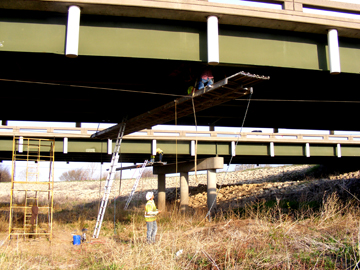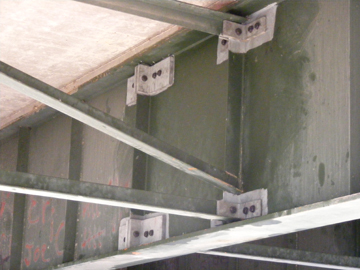KU Bridge Repair Technique Keeps Traffic Moving Near Wichita
Increasing the safety and durability of bridges while lowering construction and repair costs are the goals of a joint project by a team of researchers from the University of Kansas School of Engineering and engineers from the Kansas Department of Transportation (KDOT).

After years of computer simulation and lab testing, several KU professors, known as the Fracture and Fatigue Group, collaborated with KDOT to implement their breakthrough repair methods on two bridges on a busy, four-lane interstate highway near Wichita.
The bridges span a narrow flood control channel on the two northbound and two southbound lanes of I-135 highway in Park City, a suburb north of Wichita. Originally built in 1970, the bridges are each 250 feet long, 40 feet wide, and they were most recently resurfaced in 2004. The average daily traffic count for each bridge in 2012 was 14,850 vehicles, with more than 2,300 of that as truck traffic.
“Steel bridges like these that have thousands of trucks per day pass over them develop cracks that can potentially cause harm,” said Adolfo Matamoros, professor of civil, environmental and architectural engineering and part of the KU’s Fracture Fatigue Group – along with Caroline Bennett, associate professor of civil, environmental and architectural engineering, and Ron Barrett-Gonzalez, associate professor of aerospace engineering.
These cracks typically develop along the dozens of points where steel girders connect. These connections are designed to ensure a vehicle’s weight is distributed evenly on the bridge.
“This problem is like having a rock in your shoe that you cannot remove. Imagine trying to run a marathon like that – it doesn’t bode well for your foot. You need to find something to smooth that pressure point over and distribute it so it minimizes the damage to your foot,” Matamoros said. “That’s the philosophy behind our repair technique and it’s been very effective. You take this pressure point and spread it out so that it doesn’t harm the bridge. It’s a solution that is simple and economical to implement.”
Current procedures commonly call for only repairing cracked or damaged areas as they occur over time. KU’s approach involves workers under the bridge attaching new steel components at every connection point to relieve the pressure.

“The effect of this approach is expected to keep costs down over the years. It was designed to be a simple repair, so it takes less time. Workers are able to drill fewer holes, it’s a less complicated repair process, and on a project like this, if you’re saving time, you’re saving money, so it helps the overall bottom line,” Matamoros said.
This repair method also helps keep motorists safe.
“This does not require any lane closures, so the construction can be conducted under live traffic. Other than brief interruptions to load and unload equipment or supplies, the traveling public should not see any impact and won't even know what is going on below the bridge deck,” said Paul Kulseth, bridge maintenance plans engineer for KDOT.
In addition to the increased safety and reduced cost, KU is able to provide extra peace of mind. By conducting elaborate computer modeling and structural testing in the lab, KU can simulate 30 years of bridge wear and tear in a few months.
“We can identify for KDOT, with very low cost or risk and much greater certainty, which solutions will work,” Matamoros said. “They come into a situation where they have a lot more confidence. They’re not coming in with blind eyes. All the evidence and detail we provide means these repairs are not just a leap of faith.”
The repairs to the I-135 bridges started in early April and are expected to wrap up in May.
Funding for the research on new bridge replacement methods were made possible with help from KU's Transportation Research Institute, KDOT and funds pooled from 10 additional state departments of transportation and the Federal Highway Administration.